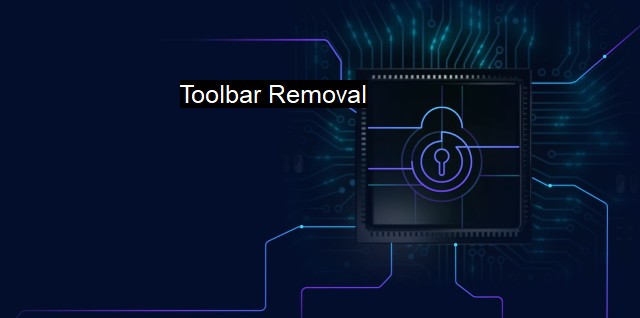What is Toolbar Removal?
The Importance of Toolbar Removal in Cybersecurity and Antivirus Software: Dealing with Harmful Browser Add-ons and Unwanted Content
Toolbar Removal is a significant process in the field of cybersecurity and antivirus software, indicating the elimination of supplementary browser toolbars that are often attached to certain programs or software. The practice revolves around two fundamental operations; protecting personal data from unapproved or unintended access as well as safeguarding the system functionality. Therefore, GreaseMonkey, a widely recognized and used browser extension, exemplifies an essential feature that can be removed to enhance browser security.A toolbar represents a row, column, or block of onscreen icons or buttons that activate particular functions of a software program. While some toolbars have a genuine purpose—like creating shortcuts for better functionality or accessibility—many also contain malicious features. Some of them surreptitiously monitor online activity, redirect user's attention to unwanted advertisements, or gather confidential or classified data. Such malevolent aspects place the user’s privacy at risk and augment the susceptibility to cyber-attacks; offering a space where Toolbar Removal finds its significance.
The action of Toolbar Removal could be seen as a preventive measure as well as a method of troubleshooting. As a security component, toolbars can sometimes pose a threat by acting as a conduit for malware, spyware, and other forms of cyber threats. As a troubleshooting element, the process is vital for curing browser-related issues such as unresponsiveness, slow speed, frequent crashes, or annoyingly intrusive online-advertisement pop-ups causing screen clutter. Therefore, different protection software or technical applications perform Toolbar Removal to mitigate such concerns. Virus protection programs will often have a toolbar remover feature as part of their utilities to provide an extra layer of security.
Situated within the broader area of antivirus and cybersecurity, Toolbar Removal necessitates an understanding of potential cyber threats precautionally. Malware authors often use deceptive toolbars to trick internet users into downloading harmful programs. The injected risks vary from annoying adware to serious Trojan horses, altering the default browser settings. This process redirects users to harmful websites, with each redirect generating advertisement revenues for the malware authors and potentially leading to more substantial security issues such as unauthorized financial transactions, identity theft, account hacking, or illegal content distribution.
The significance of Toolbar Removal cannot be overstated within the realm of antivirus. An antivirus program employs intricate procedures to detect suspicious toolbars and eradicate them efficiently. Modern antivirus software utilizes updated databases to swiftly recognize a wide range of potential threats, treat detected risks, and safeguarding a user from both known exploits and zero-day attacks. Once a threat is detected, the antivirus quarantines it, cuts it off from the system resources, and then efficiently proceeds towards elimination.
Typically, Toolbar Removal does not radically influence the user’s experience or internet usage; instead, it incrementally boosts the browser's performance and security. The process fosters periods of privacy, privilege, peace, and freedom necessary in the era of data sensitivity, offsetting possible vulnerabilities or disruptive issues.
Simultaneously, Toolbar Removal implicates the essentiality for user attentiveness while installing new software. To circumvent unwanted toolbars effectively, users need to perform custom installations, pay attention to license agreements, and, vitally, deselect options that mandate unnecessary third-party installations.
Toolbar Removal constitutes a critical module amidst a broader defensive cybersecurity strategy, informed and facilitated by advanced antivirus software. Through this practice, stakeholders can assure the integrity of their digital experiences by availing amplified browser security and performance while mitigating the likelihood of cyber-attacks, perpetuating a need to sustain the upward evolution of state-of-art antivirus systems.

Toolbar Removal FAQs
What is a toolbar, and why should I remove it?
A toolbar is a software extension that adds extra functionalities to your web browser. However, some toolbars may be malicious and pose a security risk to your system. Removing them decreases the chances of your computer being infected with malware and ensures that your browsing activities are kept safe.How can I remove a toolbar from my web browser?
The procedure for removing a toolbar varies across different web browsers. However, you can try the following steps: Go to the settings or preferences section of your browser and locate the extensions panel. Find the toolbar extension you want to remove and click on the "remove" button. Restart your browser, and the toolbar should be gone.What risks are associated with keeping a toolbar on my browser?
Some toolbars may collect your browsing data, including your passwords and personal information, and send them to third-party companies without your consent. This can lead to identity theft, fraud, and other cybersecurity risks. Additionally, toolbars can slow down your browser's performance and cause pop-up ads that can be annoying and intrusive.Can antivirus software protect me from toolbar threats?
Yes, most antivirus software is designed to detect and remove malicious toolbars and other security threats. However, it's important to keep your antivirus software up to date and perform regular scans to ensure that your system is not compromised. Additionally, you should practice safe browsing habits, such as avoiding suspicious links and downloading software only from trusted sources, to minimize the risk of toolbar infections.| | A | | | B | | | C | | | D | | | E | | | F | | | G | | | H | | | I | | | J | | | K | | | L | | | M | |
| | N | | | O | | | P | | | Q | | | R | | | S | | | T | | | U | | | V | | | W | | | X | | | Y | | | Z | |
| | 1 | | | 2 | | | 3 | | | 4 | | | 7 | | | 8 | | |||||||